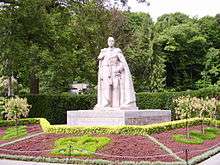Cultural depictions of King George VI
George VI of the United Kingdom is depicted in art and popular culture.
Film, stage, television and radio
George has been portrayed by:
- Andrew Ray in the 1974 LWT adaptation of Royce Ryton's play Crown Matrimonial, and in the 1978 Thames Television mini-series Edward & Mrs. Simpson
- Lyndon Brook in the 1979 BBC TV drama Churchill and the Generals
- Owen Holder in the 1986 TV drama series Lord Mountbatten: The Last Viceroy
- James Wilby in the 2002 Carlton Television drama Bertie and Elizabeth
- Anthony Andrews in the 2003 BBC TV series Cambridge Spies
- Mick Rose in the 2004 TV drama Ike: Countdown to D-Day
- Harry Enfield in the 2004 spoof Churchill: The Hollywood Years
- Bill Champion in the 2005 film Wallis and Edward
- Iain Glen in the 2009 TV drama Into the Storm
- Alex Jennings in the 2009 radio play A King's Speech
- Colin Firth, winner of the Academy Award for Best Actor[1] in the 2010 film The King's Speech.[2] The film also won Best Picture at the 83rd Academy Awards.[1]
- Laurence Fox in the 2011 film W.E.
- Charles Edwards in the 2012 West End stage adaptation of The King's Speech.[3]
- Samuel West in the 2012 film Hyde Park on Hudson.
- Jonathan Townsend in a non-speaking cameo in the 2013 Christmas Special of Downton Abbey.
- Rupert Everett in the 2015 film A Royal Night Out.
- Jared Harris in the 2016 Netflix TV series The Crown
Novels
George is a significant character in Michael Dobbs' 2003 novel Winston's War, and Len Deighton's alternate history novel SS-GB, in which he is imprisoned, and killed, during a Nazi occupation of Britain.
In the alternate history novel Fatherland by Robert Harris, George VI was deposed when Nazi Germany conquered the United Kingdom and the British Empire in the early 1940s. Most of the Royal Family were forced into exile in Canada and his elder brother Edward VIII was restored to the throne. After George's death in 1952, his eldest daughter Princess Elizabeth was recognised by the governments of Canada, Australia and the United States as the rightful British monarch.
In the alternate history novel Back in the USSA by Eugene Byrne and Kim Newman in which the United States of America became a communist state in 1917, Edward VIII almost lost his throne over his relationship with Wallis Simpson in 1936. However, the abdication was averted and he and Mrs Simpson eventually married. He remained King until his death in 1972, though with Wallis as Princess Consort rather than Queen. His younger brother Albert, Duke of York was his heir presumptive but he died in 1952. The Duke's eldest daughter Princess Elizabeth, Duchess of Edinburgh died of respiratory disease caused by London fog in 1968 while his younger daughter Princess Margaret was removed from the line of succession to the British throne as she converted to Catholicism and married a lunatic. Consequently, Princess Elizabeth's eldest son Charles, Duke of Cornwall became the heir presumptive. The Duke's wife Elizabeth, Duchess of York was still alive in 1972.
In the alternate history novel The Man Who Prevented WW2 by Roy Carter, Edward VIII was assassinated by Jerome Bannigan on 18 July 1936. It was suspected that the Prime Minister Sir Oswald Mosley, who came to power when the British Union of Fascists won a landslide victory in the 1935 election, was responsible for his murder. After his death, the BUF government abolished the monarchy and placed the Royal Family under house arrest in Balmoral Castle until they were expatriated to Switzerland in September 1939. His younger brother and heir presumptive, Albert, Duke of York (who would have become George VI if the monarchy had not been abolished), was given the deed to the Royal Hotel in Geneva. His mother Queen Mary was disturbed that he had become an innkeeper and even more disturbed that she was an innkeeper's mother. However, the Duke later established a successful hotel chain.
Comics
In Secret Origins #7 (November, 1986), George and Elizabeth are menaced by the Phantom of the Fair during their visit to New York in 1940. George fights with a robot minion of the Phantom to save his wife and himself, and is assisted by Sandman and the Crimson Avenger in the first battle between superheroes.
Statues

In 1955, a statue of the king in his Garter robes was erected just off The Mall and Carlton Gardens in London. A neighbouring statue of his wife was unveiled in 2009.[4] Other statues of the king include one in the Hong Kong Zoological and Botanical Gardens.
References
- 1 2 "Nominees & Winners for the 83rd Academy Awards". AMPAS. AMPAS. Retrieved 3 March 2011.
- ↑ "The King's Speech :: rogerebert.com :: Reviews". Rogerebert.suntimes.com. 15 December 2010. Retrieved 3 March 2011.
- ↑ Masters, Tim (17 February 2012). "The King's Speech to open in the West End". BBC News. Retrieved 19 February 2012.
- ↑ Queen Mother statue is unveiled, BBC, 24 February 2009, retrieved 22 April 2009